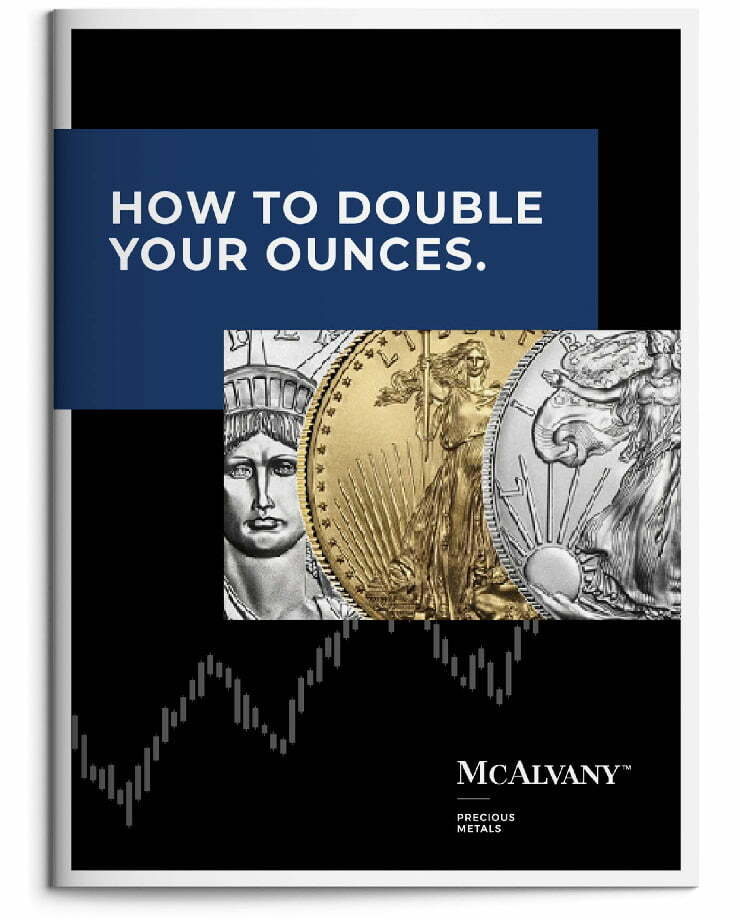Last week, HAI made the case for a massive, ongoing, structural bull market in gold. HAI also said that the violent reversal lower in gold last Friday might have been the start of a much-needed and healthy correction. This week, gold, silver, and the precious metals mining stocks all experienced price follow-through to the downside. That means the evidence of a meaningful correction has materially increased. But given the incredibly strong fundamentals supporting gold—detailed last week—we can’t take anything for granted.
What is at issue, in HAI‘s view, is the possibility of a meaningful correction, but not yet a bull market top—not by a long shot. Given the tension between arguably the strongest underlying bullish fundamentals supporting higher gold prices since the freely traded gold era began, and absurdly overbought technicals, HAI would advise keeping it simple. If one has long-term exposure, HAI suggests keeping it, sleeping tight, and looking forward to much higher prices—in time. If one has a shorter-term performance mandate or leverage, HAI would suggest playing the short-term cautiously by reducing some exposure. But again, and importantly, what’s at issue, in HAI‘s view, is a possible correction, not a top.
This week let’s update the latest reasons why. To start, let’s look stateside for an update on inflation and monetary policy. This week, CPI inflation for September increased to 3% for the first time since Trump returned to the White House. That said, the CPI data was slightly lower than expected, meaning that the data solidified expectations that the Fed will still cut interest rates again into 3% inflation (now well above the 2% target for over four and a half years) at next week’s Federal Reserve FOMC policy meeting.
That’s not an insignificant development. In fact, it’s just what has BCA Research’s attention. Just last week, BCA offered another small sign that Wall Street—and by extension the Western investor—is moving ever closer to embracing the gold thesis. BCA’s chief strategist noted that it’s “almost unheard of” in the modern era for gold to surge and dramatically outperform everything while the major market stock indexes are up double digits year-to-date.
As BCA correctly points out, when gold outperformed in the past, it was almost always when major stock indexes were down. In HAI‘s view, BCA’s explanation of that highly unusual phenomenon was noteworthy. According to BCA, gold’s incredibly strong performance reflects the company’s view that “the Fed is undergoing a regime change in which the primacy of price stability is displaced by the primacy of ultra-low real rates.” As BCA states, “this will structurally underpin hard assets like gold.”
Now, BCA’s commentary implies far more than is overtly stated. BCA’s observation indicates that it understands the government’s dire fiscal situation, the need for some form of yield curve control (or its functional equivalent), and the need to run the system very hot to inflate away the net present value of government obligations. BCA’s observation also endorses the idea of a trapped and compromised Fed forced to sacrifice its price stability mandate for a shadow third mandate—financing the government.
In HAI‘s view, we are witnessing the Western realization—in slow motion—of the inevitability described a decade ago by former Fed governor Larry Lindsay. In May of 2015, Lindsay said at a conference “this always ends this way—Rome, the Ming Dynasty, Zimbabwe…it’s so depressing. It always, always, always ends this way—this end game we’re all talking about. The financial arrangements of the state are no longer sustainable… Government will not voluntarily let itself go out of business… It will use all its powers…to fund itself.”
Importantly, and echoing Lindsay’s observation, BCA added that the “breakdown of this 50-year framework [the Fed’s primary goal of price stability being displaced by the primacy of ultra-low real rates] is presaging perhaps the biggest macro event in decades.”
In short, the global monetary system in place for over 50 years is unsustainable. As a necessary consequence, it is now changing.
This is reality, but it is a reality that the West has barely begun to mark to market. But if we combine the latest BCA commentary with other recent evidence of shifting sands on Wall Street, then perhaps we can conclude that “Steet” orthodoxy is indeed just beginning to adjust.
Several weeks ago, echoing the BCA commentary, BofA Chief Investment Strategist Michael Hartnett called for $6,000 gold this spring. He expects the combination of inflation and a debt crisis to force the U.S. into yield curve control (YCC). Both BCA and BofA analyses come after Goldman Sachs recommended that gold be added to the traditional 60/40 portfolio (60% equities/40% bonds) and after Morgan Stanley Chief Investment Officer Michael Wilson explicitly recommended the 60/40 portfolio graduate to a new 60/20/20 portfolio, with gold added as the new “antifragile” asset last month.
Meanwhile, furthering the push away from the dollar system, this week the U.S. Treasury sanctioned Russia’s two biggest oil companies, Rosneft and Lukoil, who reportedly produce approximately 5% of global oil production. The sanctions’ primary bite is in the form of penalties on third parties—China, India, and other BRICs allies—reliant on Russian oil.
In HAI‘s view, these sanctions will also act to accelerate the gold bull market. As with the U.S. freezing of Russian FX reserves in 2022, these latest actions to weaponize the dollar will also increase the global incentive to adopt a new neutral reserve asset (replacing Treasuries) into which global trade profits can be recycled and saved. That new asset is gold.
So, we now have a number of powerful active drivers of the current gold bull market. We have inflation, debt, and trapped U.S. monetary policy driving the price higher. At the same time we have a weaponized dollar and a global scramble to replace the petrodollar system (dollar recycling system) with a new gold-based global trade system.
This week on MacroVoices, Adam Rozencwajg from HAI favorite commodity research firm Goehring & Rozencwajg was asked the question of just what driver it is that’s really powering the gold bull market. Rozencwajg replied by saying, “so, is it inflation? Yeah, it’s related to inflation for sure… Is it China trying to dethrone the dollar? I think that’s definitely part of it… This is nothing if not a major monetary regime change,” before concluding, “I think it’s all of the above, and I think that’s what gold’s telling you.”
HAI couldn’t agree more, it is “all of the above.” The ongoing gold bull market is being fueled by what HAI believes to be the strongest multi-factor fundamental support for higher gold prices ever experienced in the freely traded gold era. So, in HAI‘s view, while the recent gold price volatility could be the leading edge of a correction, it’s almost certainly not a bull market top. As such, in HAI‘s view, it’s best to take famed trader Jesse Livermore’s advice to just “sit tight and be right” or even add on a dip if gold continues to correct further. While the technicals may see price retrace lower levels for a time, the fundamentals (amid what BCA Research called “perhaps the biggest macro event in decades”) are almost certainly driving gold towards a new price reality far above current levels.
Weekly performance: The S&P 500 was up 1.92%. Gold was off 3.28%, silver was down 6.46%, platinum was lower by 1.63%, and palladium lost 3.52%. The HUI gold miners index was down 7.37%. The IFRA iShares US Infrastructure ETF was up 2.17%. Energy commodities were volatile and higher on the week. WTI crude oil was up 6.59%, while natural gas gained 11.28%. The CRB Commodity Index was up 3.28%. Copper was higher by 2.60%. The Dow Jones US Specialty Real Estate Investment Trust Index was up 1.06%. The Vanguard Utilities ETF was down 0.29%. The dollar index was up 0.51% to close the week at 98.94. The yield on the 10-yr U.S. Treasury was up 1 bp to close the week at 4.023%.
Have a wonderful weekend!
Best Regards,
Morgan Lewis
Investment Strategist & Co-Portfolio Manager
MWM LLC















